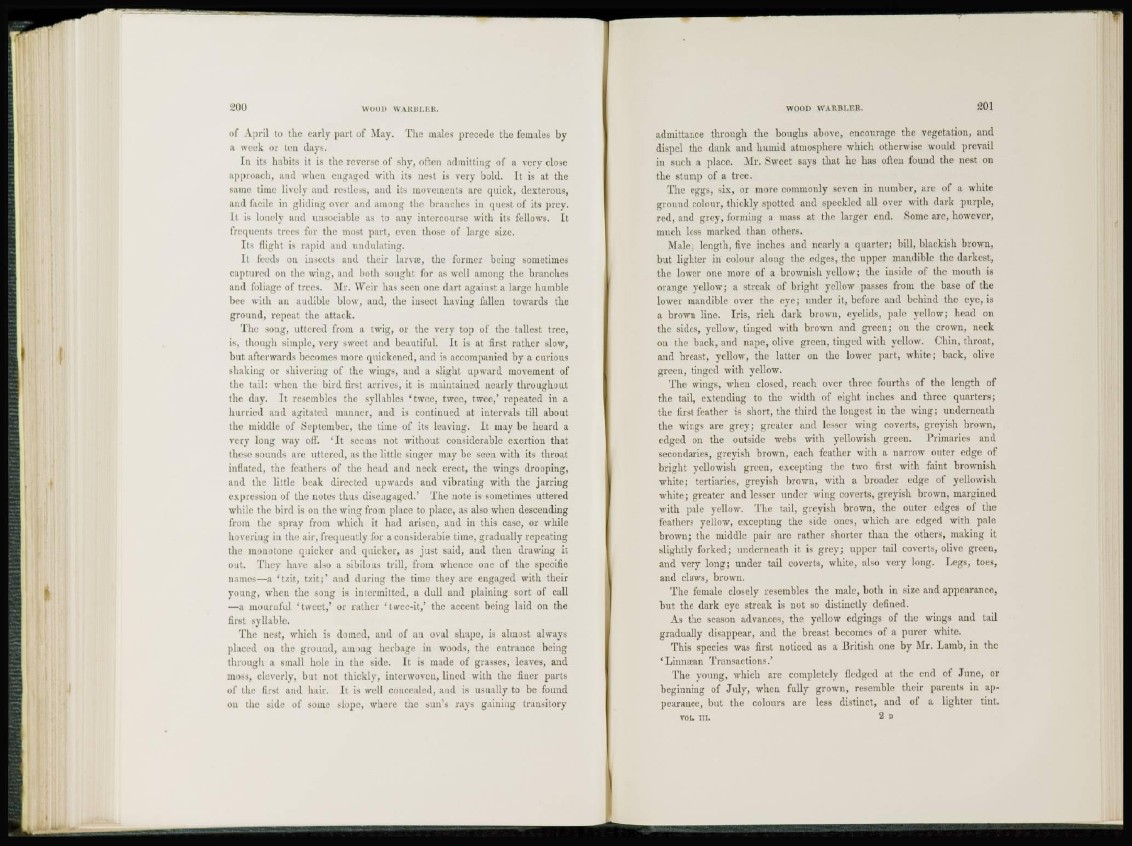
of April to the early part of May. The males precede the females by
a week or ten days.
I n its habits it is the reverse of shy, often admitting of a very close
approach, and when engaged with its nest is very bold. It is at the
same lime lively and restless, and its movements are quick, dexterous,
and facile in gliding over and among the branches in quest of its prey.
I t is lonely and unsociable as to any intercourse with its fellows. It
frequents trees for the most part, even those of large size.
Its flight is rapid and undulating.
I t feeds on insects and their larva?, the former being sometimes
captured on the wing, and both sought for as well among the branches
and foliage of trees. Mr. Weir has seen one dart against a large humble
bee with an audible blow, and, the insect having fallen towards the
ground, repeat the attack.
The song, uttered from a twig, or the very top of the tallest tree,
is, though simple, very sweet and beautiful. It is at first rather slow,
but afterwards becomes more quickened, and is accompanied by a curious
shaking or shivering of the wings, and a slight upward movement of
the tail: when the bird first arrives, it is maintained nearly throughout
the day. It resembles the syllables 'twee, twee, twee,' repeated in a
hurried and agitated manner, and is continued at intervals till about
the middle of September, the time of its leaving. It may be heard a
very long way off. 'It seems not without considerable exertion that
these sounds arc uttered, as the little singer may be seen with its throat
inflated, the feathers of the head and neck erect, the wings drooping,
and the little beak directed upwards and vibrating with the jarring
expression of the notes thus disengaged.' The note is sometimes uttered
while the bird is on the wing from place to place, as also when descending
from the spray from which it had arisen, and in this case, or while
hovering in the air, frequently for a considerable time, gradually repeating
the monotone quicker and quicker, as just said, and then drawing it
out. They have also a sibilous trill, from whence one of the specifie
names—a 'tzit, t z i t ; ' and during the time they are engaged with their
young, when the song is intermitted, a dull and plaining sort of call
—a mournful 'tweet,' or rather 'twee-it,' the accent being laid on the
first syllable.
The nest, which is domed, and of an oval shape, is almost always
placed on the ground, among herbage in woods, the entrance being
through a small hole in the side. It is made of grasses, leaves, and
moss, cleverly, but not thickly, interwoven, lined with the finer parts
of the first and hair. It is well concealed, and is usually to be found
on the side of some slope, where the sun's rays gaining transitory
admittance through the boughs above, encourage the vegetation, and
dispel the dank and humid atmosphere which otherwise would prevail
in such a place. Mr. Sweet says that he has often found the nest on
the stump of a tree.
The eggs, six, or more commonly seven in number, arc of a white
ground colour, thickly spotted and speckled all over with dark purple,
red, and grey, forming a mass at the larger end. Some arc, however,
much less marked than others.
Male; length, five inches and nearly a quarter; bill, blackish brown,
but lighter in colour along the edges, the upper mandible the darkest,
the lower one more of a brownish yellow; the inside of the mouth is
orange yellow; a streak of bright yellow passes from the base of the
lower mandible over the eye; under it, before and behind the eye, is
a brown line. Iris, rich dark brown, eyelids, pale vellow; head on
the sides, yellow, tinged with brown and green; on the crown, neck
on the back, and nape, olive green, tinged with yellow. Chin, throat,
and breast, yellow, the latter on the lower part, white; back, olive
green, tinged with yellow.
The wings, when closed, reach over three fourths of the length of
the tail, extending to the width of eight inches and three quarters;
the first feather is short, the third the longest in the wing; underneath
the wings are grey; greater and lesser wing coverts, greyish brown,
edged on the outside webs with yellowish green. Primaries and
secondaries, greyish brown, each feather with a narrow outer edge of
bright yellowish green, excepting the two first with faint brownish
white; tertiaries, greyish brown, with a broader edge of yellowish
white; greater and lesser under wing coverts, greyish brown, margined
with pale vellow. The tail, greyish brown, the outer edges of the
feathers yellow, excepting the side ones, which are edged with pale
brown; the middle pair arc rather shorter than the others, making it
slightly forked; underneath it is grey; upper tail coverts, olive green,
and very long; under tail coverts, white, also very long. Legs, toes,
and claws, brown.
The female closely resembles the male, both in size and appearance,
but the dark eye streak is not so distinctly defined.
As the season advances, the yellow edgings of the wings and tad
gradually disappear, and the breast becomes of a purer white.
This species was first noticed as a British one by Mr. Lamb, in the
1 Li nine an Transactions/
The young, which are completely fledged at the end of June, or
beginning of July, when fully grown, resemble their parents in appearance,
but the colours are less distinct, and of a lighter tint.
VOL. in. 2D